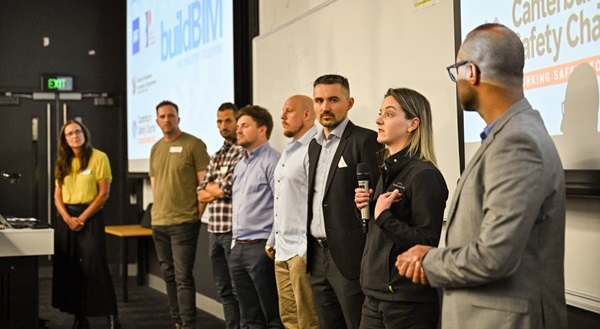We were excited to host our “Beyond the Blueprint” Summit in Auckland on February 14, 2024, at the Sir Owen G Glenn Building at the University of Auckland.
Thank you to everyone who attended. This event was a repeat of the summit previously held in Christchurch but offered an opportunity for Auckland attendees to gain insights. We were fortunate to have Jenn Dransfield from Naylor Love join us, who provided valuable perspectives from the viewpoint of a Health and Safety Manager.
The audience was captivated, informed, and challenged by the presentations. We were once again incredibly impressed by the diverse array of digital engineering tools being utilised for health and safety purposes in the New Zealand construction industry.
Attendees came away informed about the potential of BIM for future use and were challenged to educate their stakeholders as to what the capabilities could be.
We want to take this opportunity to also thank our event sponsor BUILDBIM.
For those unable to attend, below is a summary of the summits’ key highlights.
Summary of Presentations
Jo Duggan, CEO of Facilities Management NZ, was our MC and welcomed everyone to the event. She spoke of the exciting possibilities that BIMSafe offers to improve health and safety outcomes in all phases of construction, from procurement through to facilities management.
Presentation Highlight Video
The first speakers were Christo Erasmus and Mikko Anzono from Steel and Tube, They highlighted how the use of BIM modelling for reinforced steel had changed the nature of their business and enabled great advances in worker safety. Complex reinforcing could be tied above ground, and then dropped into place, eliminating the need for difficult access work.
The BIM model was available to all workers via QR codes on site, which allows for better coordination of service penetrations through the steel, and detailed information to be visually available to all workers on site.
Dean Burke from WSP then gave a presentation on the use of BIM models for health and safety training for those doing the tunnel work on the City Rail Link. Health and safety signage standards were trialled digitally before being manufactured, and new standards developed. Worker safety inductions were carried out via Virtual Reality and allowed for realistic fire and evacuation drills to be simulated without any real fires.
Driver training through the construction zone was also carried out with the model updated every three months to accurately recreate the construction site conditions.
Jenn Dransfield from Naylor Love gave a presentation on how health and safety managers could utilise BIM to their advantage. She challenged the industry to make BIM access easier for health and safety advisors and workers and spoke of having to make her own way into the BIM conversation, rather than waiting to be invited.
She told of how BIM models enable greater environmental and situational awareness for workers and provides a very effective tool for hazard identification and mitigation from those most at risk. In her words, the “magic” happens when those doing the work can openly discuss the issues by looking at the model prior to the actual construction.
Egor Jivic from Southbase highlighted the use of a BIM model for collaboration between the designers and operators of a data centre. People involved in the operation and maintenance of the facility were taken on a virtual tour of the design so that they could highlight any potential safety risks during their working days. Access, maintenance, and equipment transfer requirements resulted in several design changes to improve safe operation.
Farzam Farzadi from BECA took us on a journey through Watercare’s Enterprise Model for digital implementation for their multi-billion-dollar projects in the next 10 years. Watercare has a target of a 40% reduction in embedded carbon, a 20% reduction in cost, and a 20% reduction year on year in accidents and injuries. They plan to do this by creating an organisational environment to foster digital communities around their projects. These include digital-based ECI’s, reduction in reports and drawings and pdf files, and being able to measure the ROI of the digital processes. Farzam spoke of the need to be able to identify the value of digital tools and communicate this effectively to clients.
Robin Findlay from Auckland International Airport gave us an overview of the digitization of the Airport site, and how reality capture is being used for underground services to reduce future service strikes. Temporary works on the new terminal project has been modelled and enabled workers and the public to actively visualise the site and traffic flows during the construction sequence. BIMSafe at Auckland Airport is about being able to make better decisions based on better data.

